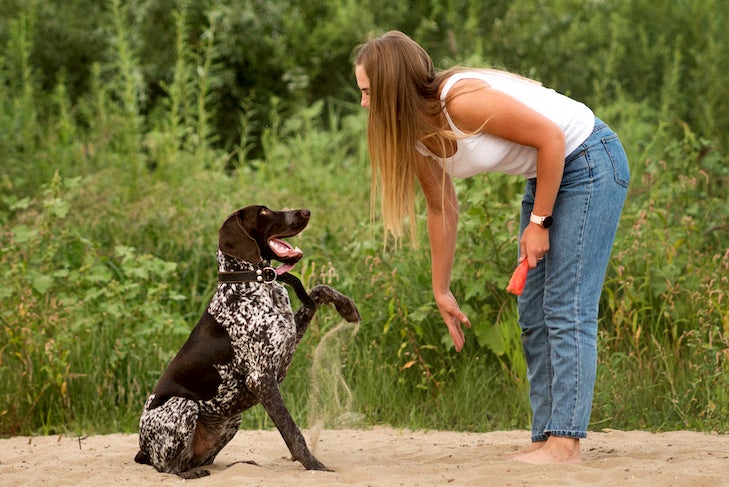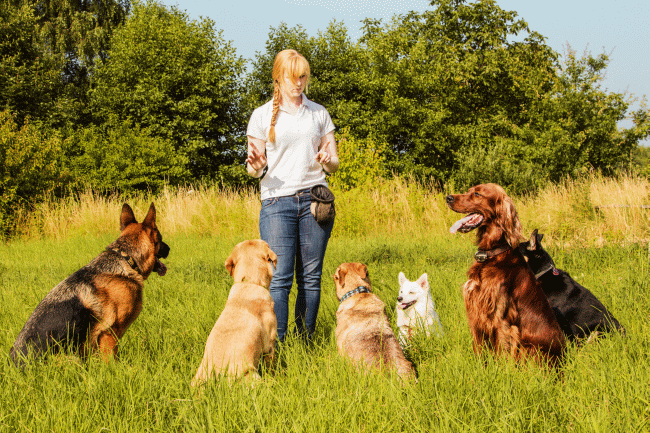Master Important Commands: Efficient Pet Training Facilitated
Reliable canine training is an essential facet of liable animal possession, and mastering important commands offers as the structure for an unified connection in between trainer and pet. Commands such as "Sit," "Keep," and "Come" not only assist in communication yet additionally advertise a more secure environment. Using positive reinforcement strategies can boost the discovering experience, yet many encounter difficulties in attaining consistent outcomes. Comprehending the nuances of canine behavior and the training procedure is crucial; nonetheless, the journey to a trained dog typically presents unanticipated difficulties that need attention. What approaches can truly change these obstacles into opportunities for development?
Recognizing Your Canine's Actions
To comprehend the nuances of effective dog training, it is important to break down and examine your dog's behavior. Dog training. Comprehending the inspirations behind your pet dog's activities is essential; actions can come from reaction, concern, excitement, or a wish for attention. By observing your canine in various circumstances, you can recognize patterns that may show underlying feelings or requirements
For instance, a pet that barks excessively may be sharing boredom, anxiety, or a requirement for social interaction. On the other hand, a dog that shows damaging actions could be looking for excitement or alleviation from tension. Recognizing these triggers allows you to customize your training approach properly.
Additionally, it is important to think about the pet dog's breed features, as they can influence behavior dramatically. Some types are inclined to certain attributes, such as herding or safeguarding reactions, which can impact their responses to certain stimulations.
Last but not least, uniformity in your feedbacks to your pet's actions promotes a much better understanding in between you and your animal. This shared comprehension is foundational for building trust and facilitating an effective training procedure that supports both behavior improvement and positive reinforcement.
Essential Commands to Teach
Educating necessary commands is an essential aspect of efficient pet training, offering the foundation for a mannerly and responsive pet dog. These commands not only enhance interaction in between the proprietor and the pet dog yet likewise guarantee safety in different environments.
One of the most important commands consist of "Sit," which urges your pet to remain fixed and tranquil; "Remain," which reinforces the idea of remaining in one place up until released; and "Come," which is essential for remembering your pet from potentially harmful situations. "Down" shows dogs to relax, promoting relaxation and control, while "Leave it" assists protect against dogs from grabbing dangerous or unwanted things.
" Heel" is another important command that encourages your pet dog to stroll very closely close to you, improving leash good manners. Lastly, "No" functions as a vital boundary-setting command, aiding to deal with undesirable behaviors.
Training Methods for Success
Effective pet dog training counts greatly on using a variety of techniques that accommodate both the canine's understanding style and the owner's training goals. One key technique is favorable support, which involves fulfilling desired habits with deals with, praise, or play. This approach urges the dog to duplicate those behaviors, cultivating a solid bond between proprietor and animal.

One more effective technique is clicker training, where a distinctive noise, made by a remote control, notes the exact minute a canine performs a preferred action. This precise timing aids canines link the habits with the benefit, enhancing their understanding.
Consistency is critical in all training approaches. Developing clear commands and maintaining the exact same cues assists the pet dog understanding expectations much more rapidly. Furthermore, brief, interesting training sessions prevent boredom and increase retention.
Integrating socializing opportunities is additionally vital. Subjecting pet dogs to different environments, individuals, and other pets aids them develop confidence and adaptability.
Finally, perseverance plays a considerable role in effective training - Dog training. Each pet dog learns at their own rate, and recognizing this can lead to a more delightful training experience for both the owner and the pet. my website Executing these techniques will set the structure for effective canine training
Common Challenges and Solutions
Despite the finest training methods, dog proprietors frequently run into common difficulties that can hinder progress. One common problem is incongruity in commands and signs. When family participants make use of various commands for the very same actions, it confuses the pet, bring about inconsistent reactions. The option exists in developing a unified strategy amongst all member of the family, making certain that every person uses the same terms and signals.

Furthermore, some canines may show stubbornness or absence inspiration. This can usually be resolved by integrating positive support strategies, such as treats or praise, to motivate desired behaviors. Tailoring rewards to what your dog locates most encouraging can considerably improve their interaction.
Finally, anxiety or anxiety can restrain progress in training. Acknowledging indicators of tension and adjusting the training speed appropriately is critical. Employing gradual exposure to been afraid stimuli can help build self-confidence in time, helping with a much more reliable training experience.
Keeping Uniformity and Perseverance
Uniformity and perseverance are paramount in canine training, as they create the structure for attaining long lasting behavioral adjustments. Pet dogs prosper on routine and clear assumptions; thus, maintaining a constant approach in commands, benefits, and improvements is vital. When trainers use the exact same cues and recommended you read signals dependably, pet dogs are better able to grasp what is being asked of them. Inconsistency can result in confusion and stress, threatening the training procedure.
Dogs, a lot like human beings, have differing discovering speeds and may not comprehend commands promptly. Positive reinforcement plays a crucial role here, fulfilling desired behaviors and aiding to cultivate a trusting relationship between the canine and fitness instructor.
Verdict
Mastering vital commands is fundamental to reliable pet dog training, promoting enhanced communication and enhancing positive habits (Dog training). Eventually, a well-trained dog not only shows great behavior but likewise develops self-confidence, adding to an unified partnership between the dog and its owner.